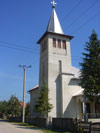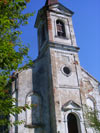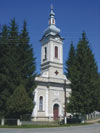Churches and Historical Monuments; Abbeys
Churches
Wherever we are and no matter what goods we have, we often feel the need for spiritual “rest”, for solitary meditation and cohabit with god. All these noble ideas are nowhere else to find but in the “spiritual Fortress” of the Christian church.
The churches were dedicated to God and set up to be real spiritual-life oasis, to relief grief and pain, for the confession of the sins but also for the education of the Romanian population that has been deprived of schools in the past.
Such Transsylvanian-style churches can be found in almost all villages on Somes’ valley in the entire Salaj County and even in Maramures. They witnessed an agitated of this land. Among the most representative ones that still carry traces of the past, we mention:
 “The nobles’ church” in Ileanda, built of wood in 1441 on the place called “Buruieni” (weeds). Here was initially situated the village but it was later removed to the hilly region because of the floods, fires and robberies. This church has served as the village church until a bigger one was built in 1730, called the “Bridegrooms” church. Later it was demolished and on its place the present Orthodox church has been set up;
“The nobles’ church” in Ileanda, built of wood in 1441 on the place called “Buruieni” (weeds). Here was initially situated the village but it was later removed to the hilly region because of the floods, fires and robberies. This church has served as the village church until a bigger one was built in 1730, called the “Bridegrooms” church. Later it was demolished and on its place the present Orthodox church has been set up;-
The wooden church from Podis is now a historic monument and was dedicated to the saints Michael and Gabriel. It has a bell from 1671 with the inscription “Ano Domino 1671”. Inside the 1780-built church you can see icons and paintings on wood that are deteriorated by the passing of time;
-
The 1580-built church from Negreni is similar to the one in Podis but besides, its iconostasis has two little doors that prove its age;
-
The church in Rastoci is also a historic monument and situated in the middle of the village on a piece of elevated ground, near the road to Jibou. It was built and painted between 1827-1836 and it has the same genuine features in the Romanian traditional style, specific for the Northern Transsylvania, like the other above mentioned churches. It has a high, beautifully arched vault, supported by chiseled beams. The tower is twice as high as the church, with a lithe silhouette, pricking the clouds like a spear. Its roof is covered with chap boards and the vault with paintings on fabric;
-
 In Ileanda, there is a Calvinist one that was built in 1890 and is lying at the foot of Ciuha Hill. Not existing Magyar population in Ileanda it is closed.
In Ileanda, there is a Calvinist one that was built in 1890 and is lying at the foot of Ciuha Hill. Not existing Magyar population in Ileanda it is closed.
 Another church is the Roman-Catholic one which lies in the village’s center and was built in 1918 by Italian prisoners, now has been hired to the Greek-Catholic flock.
Another church is the Roman-Catholic one which lies in the village’s center and was built in 1918 by Italian prisoners, now has been hired to the Greek-Catholic flock.
For the tourist that remains longer in Ileanda, a visit to the famous monasteries of Nicula and Rohia would pay off. Their fame crossed the country’s boundaries and attracts hundreds of thousands of people. They lie not far from our commune in a very picturesque neighborhood:
Abbeys
-
The Nicula Monastery, is known through its wonder making icon representing the Holy Virgin and through its icon painting school. You can reach it by driving on DN1 Baia Mare – Cluj motorway to Gherla and from there to the village of Nicula, which is situated at a 5 km’s distance from the latter.
The monastery’s first attestation was in some 1552 documents. It was built of wood, renovated in 1714 and destroyed by a fire in 1974. It has been replaced by another church that shelters some representative icons.
The great church was built of bricks and stone in 1875-1879 and dedicated to the “Dormition of the Holy Maria”. The iconostasis that was replaced in 1938 is impressive, unique in our country. It is made of lime-tree wood and has in its middle a beautiful cross, supported by the holly doors. The rays surrounding the cross are propped up on the arch. They have medallions of size with 12 Apostles painted on them. In the middle medallion the Holy Trinity was painted.
On February 15 and March 12, 1699, the icon of the Holy Virgin shed tears and since then, many wonders have been committed in front of it. There are also a workshop for painting icons on glass and a museum where they are exhibited.
The Rohia Monastery, is situated in “Lapus Land”. You can reach it by following route 17 via cheile Babei, crossing the town of Targu Lapus and from there at a few km’s distance you’ll find the village of Rohia. The monastery lies in the middle of a beech and oak forest, on the peak of “Dealu-i vie” hill. The church was built in 1923-1925 and blessed in 1926.
The legend says that the priest’s little girl urged him to build the monastery at that time. She had a vision of the building and its place. She died at the age of 10.
Since 1953, there are a monastic school and a library with over 20 thousandths religious books, theological magazines and valuable scientific works.
You enter the monastery’s yard through a superb Maramures gate. Among the monastery’s buildings, the most important are: the house made of oak wood, the abbey lying on a cliff, the monumental house with the chapel and the “House on the hill”.
You enter the monastery’s yard through a superb Maramures gate. Among the monastery’s buildings, the most important are: the house made of oak wood, the abbey lying on a cliff, the monumental house with the chapel and the “House on the hill”.
Although it is still young comparative to other monasteries in our country, its name penetrated even the folklore and literature. The scenery, the monastery with its inhabitants and the pilgrims impresses the poem writer Ion Alexandru who has here a house – “the poet’s house”.
The monastery has in its patrimony a large number of old icons, paintings on glass and wood for which a museum has been arranged.


